|


6. The
S.S. Alpha and the River Routes

|
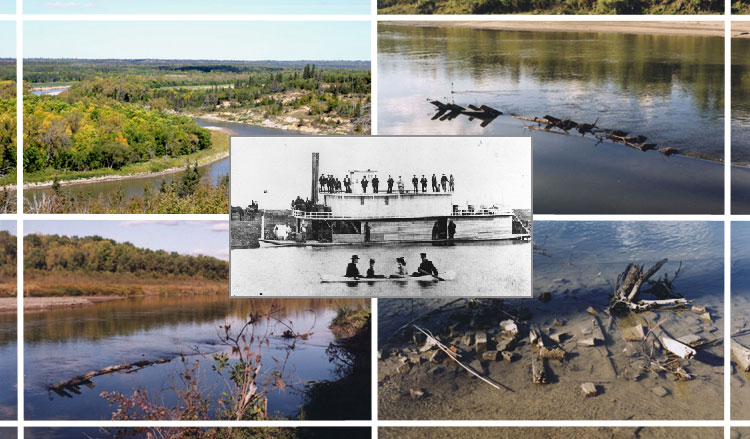
The story of the Alpha
first came to my
attention through the work of
Brandon's Roy Brown. This story therefore owes a considerable debt to
Mr. Brown for his "Steamboats on the Assiniboine" and "Mystery Ship of
Spruce Woods". Other works that were quite helpful in the beginning of
my research were; Bruce Peel's "Fire Canoe", Mary
McCarthy's, "Steamboats on the lakes and rivers of Manitoba
1859-96", and several articles by Loudon Wilson in the American
periodical, "Steamboat Bill Of Facts".
What I have tried to do is add to the work of
the aforementioned
writers and continue their efforts through the use of additional
evidence, photographs, maps and site visits. In this quest I was much
aided by a service unavailable only a few years ago. I refer to today's
easy access to the on-line searchable copies of pioneer-era newspapers
provided by "Manitobia" and by "Paper of Record". The articles and
display advertising in the old papers has made it much easier to get a
feel for the times, and has allowed me to track down events that seemed
inconsequential at the time but upon which hindsight has lent some
weight.

A
Starting Point
I
believe I can trace my interest in riverboats to my first reading of
Huckleberry Finn as a child. There is something appealing about
slipping away from moorings, casting off from terra firma, while at the
same time keeping the comforts of home. Part of the attraction was that
it was exotic, in a frontier kind of way – something that
happened, and only could happen, far away. So when I discovered, much
later in life, that Manitoba, including my part of Southwestern
Manitoba, for a brief time had its own paddlewheel riverboats, I was
somewhat surprised.
My education began in the 1980s when I read a
story in the Cypress
River local history (1) about the Alpha, the last of the Assiniboine
River steamboats, the remains of which just happened to be buried in a
sandy riverbank a short distance north of that town. Now that caught my
attention. Something about actual artifacts makes history a little more
real for me and motivated me to learn more. Our history books, in their
accounts of the opening of the west, had ignored a little bit of
transportation history. Steamboats, not the CPR, were the first
mechanized freighters on the prairies. The local history inspired me to
mount a search for the site, but although I knew roughly where to look,
the river levels that year were too high to reveal anything to my
untrained eye.
The Cypress River historians had reprinted
some of the work of Roy
Brown who in 1969 learned of the existence of remains of a large
riverboat in Spruce Woods Park and decided to investigate. He was able
to track down enough evidence to assure us that the remains were those
of the Alpha. In his booklet "The Mystery Ship of the Spruce
Woods", [2] he combines local reminiscences and documented records to
retell the story of the unlucky vessel. He went on to write
“Steamboats on the Assiniboine” which gives us the larger
picture of the whole Assiniboine River fleet.
In the mid 1990's while doing
research for my
book "False Starts: The
Story of Riverside Settlements in the Souris Mouth Area". [3] I noted
that accounts by pioneers from local histories would often mention the
riverboats. I had, until that time, considered the steamboats as
perhaps a short-lived experiment, interesting but of little impact;
hardly an important element of the settlement experience. But as I read
through various pioneer stories, it became evident that the Alpha, and
her sister ships, were anything but curiosities; they were part of a
well-conceived transportation system that, albeit for a short time,
played a vital role in the pioneer narrative. During the 1870’s
large steamboats, similar in style and purpose to the Mississippi
riverboats we had learned about in school, but adapted for the
shallower Red River with wide beams and shallow drafts, were an
important link with the outside world – moving both passengers
and freight in and out of Winnipeg. In fact, the first steamer arrive
in Winnipeg, the Anson Northup, was rebuilt from an old Mississippi
River boat. [4]
The use of steamboats in western Manitoba,
was, as it had been in the
opening of other frontiers, an important, though short-lived, element
of pioneer life, filling a transportation gap that always existed in
that period between the arrival of settlers and the arrival of
railroads. Beginning in 1879 and for several years afterwards, settlers
headed for districts south of Brandon often took a steamer to the
Cypress River or Souris Mouth area and set off across the prairie
trails for homesteads to the south. In fact, ads for the steamboat
companies promoted the advantage of such a course, [5] and
Wyatt’s 1881 guide for settlers included this helpful chart of
distances: [6]
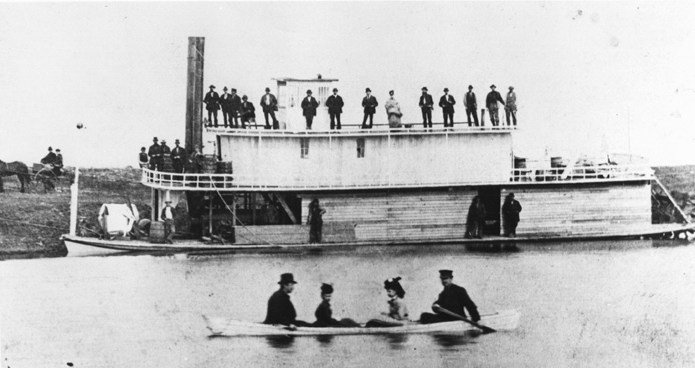
Taken 1878
(Manitoba Archives)
The boat was built in 1873 in Brekenridge Minnesota. This picture was
taken shortly before it was moved to service on the Assiniboine.

From "The
Manitoban" 26/07/73
Having
acquainted myself with the beginnings of an understanding of the role
played by the riverboats I once again turned my attention towards
searching out the resting place of the Alpha. When, in the fall of 2003
I noticed that the water levels on the Assiniboine were lower than I
had ever seen them, I realized that might not get such favorable
conditions again. According to Roy Brown, who visited the remains in
1969 and interviewed people familiar with the site, the beams of the
starboard side were under two feet of water, while remains of the port
side could be seen buried in the bank. I knew that thirty more years of
spring floodwaters would have taken their toll on anything buried in
the bank, but hoped that the low water would reveal whatever was left
on the river floor.
So it was, that on a on a fine autumn
afternoon, with my wife and one
of our sons by my side, I set out to find the Alpha.
For the record, the Alpha was built in
Breckenridge Minnesota by
Captain Harrison of Wayzata, Minnesota, and Captain J. W. (Flatboat)
McLane of Winnipeg. It was built of Wisconsin oak; 105 feet long,
with breadth of 24.5 feet, and with a draught of 12 inches and it was
launched on July 5, 1873. [7] The intention was to join in the
blossoming Red River traffic linking U.S. centres with Winnipeg, but
Mr. McLane, being British, could not get the boat registered for U.S.
service. That worked well for Norman W. Kittson, of St. Paul, who was a
U.S. Citizen, although Canadian born. (Kittson’s grandfather was
noted fur trader and a relative of explorer Alexander Henry.) [8] Mr.
Kittson, who later would play a role in the establishment of the
C.P.R., was just beginning to establish the Red River Transportation
Co. with backing from the HBC who needed an American partner to operate
in the US. [9] The Alpha quickly became his ship and was soon a fixture
on the Red River.
During the summer in the mid 1870’s The
Manitoba Free Press
regularly printed a column entitled “River News” announcing
the arrival and departure of the boats, and detailing passengers and
freight carried. In most papers the Local News section was seldom
without some news item relating to the boats. A typical entry
from May 8, 1875 read, “The steamer Alpha arrived at noon on
Tuesday, with three passengers and about three hundred and fifty tons
of freight” [10] Or this one from the Manitoba Free Press of May
18, 1878; “The Alpha left for Portage on Saturday evening with a
cargo of lumber and merchandise and a few passengers.” [11] The
big boats were the height of sophistication in terms of passenger
service, and vital for the transportation of both imports and exports.
Their comings and goings were the talk of the town, one paper even used
the byline; “Shipping News”. [12]To keep it in
perspective, the papers also regularly published lists of patrons of
local hotels under folksy headings such as “Strangers in
Town”. A scanning of the dailies of the time certainly confirms
that the river traffic played a major role in opening up our newly
created province.
When the Alpha operated on the Red throughout
the mid 1870’s, it
was reportedly one of the fastest boats on the river. [13] In fact the
Alpha is credited with a number of noteworthy achievements. It
was the Alpha that delivered sixty-three men of the newly formed North
West Mounted Police from Winnipeg to the “Stone Fort”
(Lower Fort Garry) in the fall of 1873 where they were to undergo
training. [14] In1875 she is credited with hauling the
“largest load ever brought down the Red River” (900 tons
– to West Lynne)) [15]
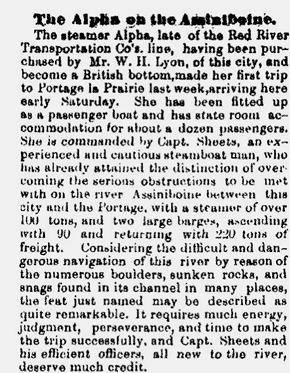
Manitoba Free Press
March 30, 1878
Noted for
her
ability to travel in low water she stepped in when other boats
couldn’t make it such as the time in 1876 when the Selkirk
couldn’t make it upstream as far as Red Lake so the Alpha was
dispatched to fetch the cargo. [16] In 1878 the Manitoba Free Press
reported that she handled the first direct exportation of wheat”
5200 bushels she brought to Winnipeg and transferred to the Minnesota
for shipment through the US route. [17] In 1879 when a mishap sent the
Manitoba to the bottom of the Red near the US Border the Alpha was sent
down to rescue her cargo. [18] On shallow prairie rivers sinking a boat
didn’t necessarily end its career; it was just another obstacle
to be overcome. Keeping a prairie river fleet operational often
involved repairing and re-floating them after mishaps and the Manitoba
was soon raised and put back to work.
The
much anticipated coming of the railway to Winnipeg in 1878 signaled
the end of the steamboat era on the Red but a group of Winnipeg
entrepreneurs, seeing an opportunity, bought an entire fleet with the
intent of establishing operations on the Assiniboine. An ad in the
Winnipeg Daily Times calls attention to “The Winnipeg and
Northwestern Transportation Company” operating on the Red and
Assiniboine Rivers with its boats being the Minnesota, Manitoba,
Cheyenne and Alpha. [19] Already a veteran of the Red River
trade, the Alpha became the first large steamer to see regular service
on the Assiniboine in 1878, when after “extensive
repairs” she made her first of many trips to Portage.
[20]
The
trials and tribulations of one of these early voyages is
colourfully detailed in a Manitoba Free Press article of the time which
heralds the “energy, judgment and perseverance” of Captain
Sheets and his crew as they negotiate the cumbersome vessel through
rock-strewn shallows, “warping” it upstream over boulders
and rapids by “the use of the ‘nigger’ or steam
capstan and a line three hundred yards in length” and using the
same rope in “dropping” it through the same rapids on the
way back, dodging snags and sand bars, braving headwinds and rain. [21]
The return trip took four days, but the immense size of cargo they
could haul more than made up for the lack of speed.
Coinciding
with the decline in demand on the Red was a change in
settlement patterns in Manitoba. With the good land of the Red River
valley largely taken, and the area immediately west of Winnipeg
occupied, settlers began to trickle into southwestern Manitoba, which
until the boundary extension in 1881 was still part of the Northwest
Territories. They walked, they piled their scant belongings into ox
carts, and they followed the old fur trader’s trail in
horse-drawn buggies. Once again, following the pattern established
throughout the west, the steamboats moved in to serve that interval
between the arrival of settlers and the arrival of a railway.
In
1879 the Marquette, the larger and newer than the Alpha, endeavored
so see just how far west it could go. Its first trip of that spring
took it to at the foot of a lengthy set of rapids just east of Brandon.
A log of that trip notes that they stopped to unload a passenger and
some freight at Cypress River. [22] This would be the beginning of the
establishment of a series of riverboat landings established to service
the riverboats. There was money to be made selling the green cordwood
the boats used for fuel and in providing storage and primitive
warehousing space.
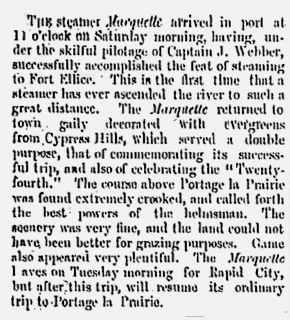
Winnipeg Daily Times
May 26, 1879
Currie’s
Landing, at the foot of the rapids just a few kilometres downstream
from the Brandon, quickly became the major docking and warehouse
facility and served as a dropping off point for settlers heading to the
Little Saskatchewan area and beyond. This point has also been referred
to a “Rapid City Landing” being the closest on could get to
that booming and ambitiously named little town 30 km to the north. The
McVicars who had settled at Grand Valley in 1878 built a steamboat
landing.
Brandon
was not yet on the map. Mair’s Landing, near the site of
old fur trade posts a few kilometers west of the Souris Mouth was
another such jumping-off point.
On
the Marquette’s first trip to what would soon become the
Brandon area, Captain Jerry Webber scouted the “Grand
Rapids” near Currie’s Landing with an eye towards giving
them a try and on his next trip and he did just that! [23]
On
its next trip he made it all the way to Fort Ellice (near St.
Lazare), and the upper Assiniboine was open for business. Before long
the
Alpha and others followed and regular service was established. Thanks
to D.C. O'Keefe, who was heading west as part of s survey party, we
have a letter printed in the Winnipeg Daily Times in the summer of 1879
with a detailed acount of a voyage on the Alpha all the way to Fort
Ellice, which quickly came to rely on the boats for a goodly portion of
its transportation of both people and freight. He notes "the
never ending S's of the river..." asserts that he had never yet seen
" a land which presents a grander appearance than the great valley of
the Assiniboine from Souris River to Fort Ellice" and reminds us that
the area was indeed a lonely place as he "saw two white men, two
Indians, and three half-breeds" between Cypress River and Fort Ellice."
[23A]
Other
passengers on one of the Alpha’s 1879 trips included
Richard Cory and his son Gus, the first settlers in the Wawanesa area,
who embarked at Portage, where they worked long enough to buy a team of
oxen and other supplies before eventually making their way to their
homestead where they helped establish a thriving community of Souris
City. [24] . In 1879 as well, the Alpha brought the
Whellan's party of English settlers to their new home at Rapid City.
[24A]
Thanks
to Alexander Reid, a young pioneer from Scotland, we have a
first-hand account of one of those early trips left to us in the
form of letters he send home. Alex was on his way to the newly created
village of Millford, the first village in western Manitoba south of the
Assiniboine, and just happened to have as travel mates the owner of
that new village, Major R.Z. Rogers and the noted Manitoba surveyor D.
C. Caddy who created the detailed village plan.
One
letter begins:
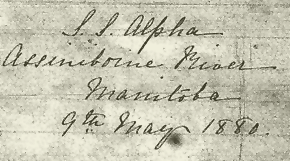
What follows is a detailed
first hand account of a riverboat trip with
details such as this:
"I
am having a good time on board, there are such nice people. We have
concerts on the moonlight steaming up the River. Last night we all got
off the Steamer & took the Ladies to see an Indian Encampment. One
of their men had died & been buried that night-, they were going to
have a feast- of one of their dogs they had killed, & also a
lamentation which was a most absurd sight." [25]
Pioneer
Robert Little, of the Cypress River area noted in his memoirs
that he regularly took the steamboat “when the stage of water
permitted” .[26]
 River
Levels
River
Levels
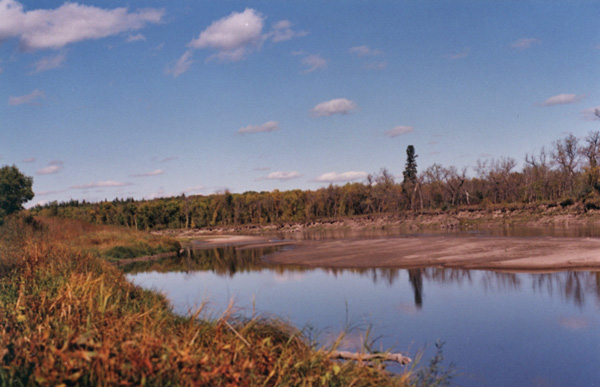
In the late summer a sand bar
divides
the sluggish current of the Assiniboine into two shallow channels as it
meanders through Spruce Woods Provincial Park
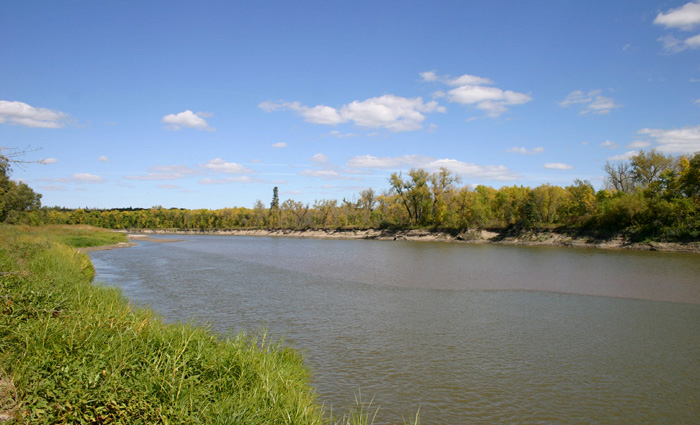
Earlier in the
summer it
is navigable.
Learning about the
role played by the Alpha was rewarding, but it wasn’t going to
help me find the remains. To help with that I had acquired a good map,
and reviewed some details of Mr. Brown’s work. He had reported
that the remains were located on the south bank of the river on 33-8-12
R.M. of Victoria. The map showed a road heading north from Highway #2
about a half mile east of Cypress River that looked like it would get
me close to that spot. And so it did.
Turning
off of highway #2 the grid road was flanked by the occasional
farm site, some with modern bungalows and well-kept lawns, some long
abandoned and overgrown, and no doubt, some ploughed over with all
traces of the yards vanished. These were the ghosts of some of the
homesteads served by the riverboats
The
grid road soon became a sandy trail, rough but very passable in dry
weather. We were leaving productive cropland and entering the lumpy
hills trimmed with spruce and aspen, good only for pasture. A fork in
the road gave us a choice and we turned right. We soon came to the
Hog’s Back Trail, where we later discovered an unmarked trail to
the east of the clearly defined Hog’s Back Trail that offers a
great hike that ends right where the “road” ends. This time
however we kept driving and the trail bent down the valley wall and
ended at a stubble field, actually a little crook of private cropland
jutting into the eastern edge of Spruce Woods Provincial Park. We
skirted the field to the left hoping for easy access to the river.
Because the Section-Township-Range numbers were all I had, the boat
could be anywhere along a twisting mile of river. I decided to try to
find access to the left part of that mile and comb the riverbank
walking east. As it turned out there was no obvious easy access to the
river. Dense bush, tangled undergrowth, and fallen trees made for tough
going. The easiest route I could find took us to roughly the middle of
the one-mile stretch, as far as I could tell.
We
descended the bank to the river and on to a huge sand bar that
stretched over half way across what normally would be river channel.
A
steamboat on this friendly little stream seemed an unlikely
possibility. But upon reflection, and using a little imagination, one
could begin to see the possibilities. It was over hundred metres to the
other side, and the sand banks were sometimes six metres tall and
showed evidence that water had indeed brushed against them. I reminded
myself of springtime canoe trips down this very stretch of river with
the current whisking you along and the flow at times reaching over the
banks. Those must have been the conditions when the Marquette made that
historic first trip from Winnipeg to Fort Ellice and back, a distance
of over 1600 km by river, in thirteen days! [27]
Yes
imagination was a factor – that and the fact that the only
other high-tech transportation available for taking heavy loads of
freight to the new settlements involved oxen, slow beasts indeed, or
“shanks mare” as foot travel was called.
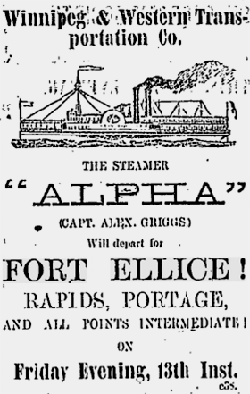
Winnipeg
Daily Times
June 13, 1879
The Assiniboine
River rises in northeastern Saskatchewan near the town of Preeceville
and flows south and east to towards Manitoba. Near Roblin its true
course along the border is now hidden for fifty kilometers by the Lake
of the Prairies, essentially a flooded river valley behind Shellmouth
Dam, and at the spillway it resumes its twisting course southwards to
St. Lazare. It there accepts the input from the QuAppelle, a similar
stream flowing all the way from the Moose Jaw area, and roams eastward
towards Brandon and Winnipeg where it joins the Red. Along the way it
picks up some momentum near Brandon where the Little Saskatchewan pours
in from the north and near Treesbank where the Souris River, which also
originates in Saskatchewan and arrives by way of North Dakota, adds it
waters.
At
first glance it seems an immense watershed. A closer look reveals
that all four rivers combine to occupy a middle ground between larger
drainage systems that flow southwards to the Missouri, northwards into
the Saskatchewan or east to the Red. But it’s a lot of real
estate, and it reminds one that on the prairies the rivers can be long
without being too deep as it were. Our low rainfall and long winters
makes them quite seasonal. Raging torrents in the springtime, rocky
trickles in the fall, and the Assiniboine is the quintessential prairie
river.
Another
feature of prairie rivers is that in addition to being
seasonal, they are cyclical. Ten tears of drought might be followed by
five years of heavy rainfall. Where one to visit the prairies during a
dry spell, as Captain John Palliser did in 1857-59, one might conclude,
as he did, that the prairies south of the north branch of the
Saskatchewan river were little more than a desert. [28] If one visited
in the wet cycle as John Macoun did in 1879 and 1880 it seemed obvious
that this same area was the future breadbasket of the continent. They
were both right, but Macoun had the ear of the directors of the CPR and
the railway changed its mind. [29] The southern plains of the prairies
were going to get a railway and settlement would follow. In fact
settlement was already happening and the steamboats were already
providing transportation with style for the few months of each year
when the spring runoff made the Assiniboine navigable.
 The Brandon Rapids
The Brandon Rapids
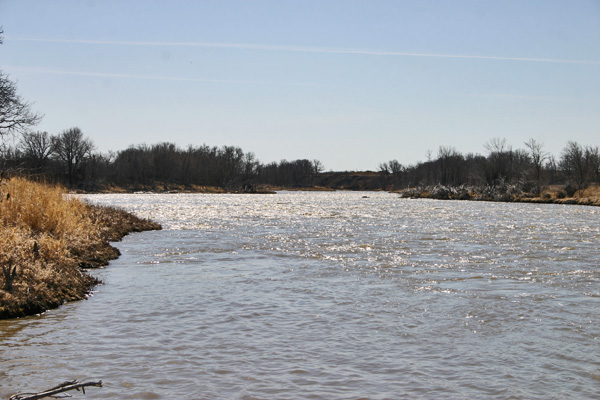
The upper part of
the
Brandon Rapids.
Although by the
early 1880's the Alpha was being referred to as the smallest and
homeliest boat on the river, she was also credited with being the most
persistent. Fair enough. In 1882 the newly built Northwest at 200 feet,
dwarfed the Alpha and carried twice the cargo, but the Alpha with her
shallow draft was able to continue operations on the Upper Assiniboine
as far as Fort Ellice as she had been doing for some time. A Winnipeg
Daily Times story from May of 1881 notes the arrival of the steamer
City of Winnipeg back from a trip to Grand Valley where it had
transferred cargo and passengers to the Alpha for the journey upriver
to Fort Ellice. [31] Allowances were also made in schedules to enable
connections with the trains when they began operation in 1881.
[32] For several years the ads and reports in the Winnipeg papers
indicate that the Alpha would do spring service on the Assiniboine then
move on to the Red where she could operate until freeze-up. [33]
The
Assiniboine did indeed provide a somewhat hazardous trail for the
big steamers. Narrow, shallow, and full of tight turns and hidden
sandbars, it was a challenge to say the least. This excerpt from an
1881Winnipeg Times account of the Marquette’s trip to Fort Pelly
accounts for a slow ride in this way:
“When
the facts as taken into consideration that the officer in
charge had to feel their way, in many cases running over prairies, and
turning bends forming the sharpest of acute angles, beside the lack of
fuel incidental to streams within the bounds of civilization. not
taking into account the necessary delays resulting from severe
winds. storms etc…” [34]
The
upstream trip, against the strong spring current was a slow ride.
Passengers would often get out and walk as the boat struggled around
the twist and turns. As noted earlier, accidents happened. The Winnipeg
Daily Times feature story on the Marquette's ground-breaking trip to
Fort Ellice in the spring of 1881 offers a gripping account of the
time-consuming attack on the rapids near Brandon, indicating that they
"extend for two miles and very swift".
With
the arrival of regular rail service in 1882 several of the
surviving boats were moved to the Saskatchewan River by way of Lake
Winnipeg and Grand Rapids. Although train trips were not as romantic
and adventurous as a riverboat ride, the schedule proved to be much
more reliable and convenient. But the Alpha had outlasted most of her
contemporaries and continued serving locations that hadn’t yet
been reached by the rails. One such area was the extensive territory
between Brandon and the U.S, Border. It was rapidly filling up with
settlers and while they clamored loudly for rail service and cursed the
C.P.R. monopoly that they felt was to blame, they were thankful for the
few hardy boats like the Alpha, now an aging relic after twelve years
service, that remained.
I
wonder if anyone at the time saw any irony in the fact that one of
the Alpha's duties in the spring of 1882 was helping the C.P.R. A
report in the Manitoban doesn't specifiy just how, but merely indicates
that she had been "detailed to assist the railway authorities with
their contention with the freshets on the Assiniboine between Willow
Creek and Brandon." [35A] In an era of rapidly change, the boat's
owners sought any work available.
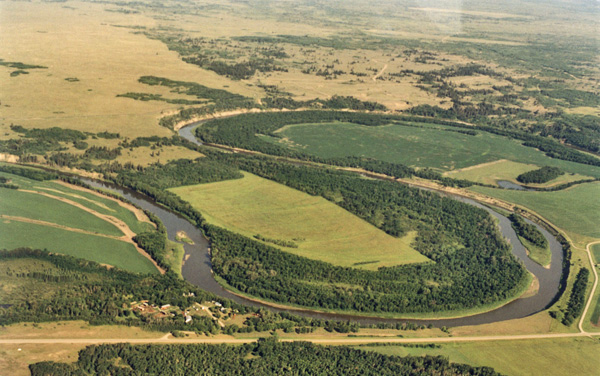
This s-loop
alongside
Highway #5 north of Glenboro helps to explain why steamer voyage on the
Assiniboine seemed to take forever.
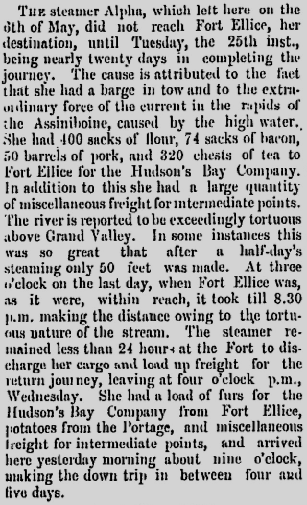
Winnipeg Daily
Times, May
13, 1880
The Alpha’s
first voyage of the 1885 season turned out to be her final voyage. She
sat in Brandon over the winter where reports in the Brandon Sun
indicate she was in need of some repairs. In fact she just escaped
destruction the previous spring in Brandon BDS220484 and by October we
find her “now sunk in the creek” [36] But she was
raised in November and readied for her final year. [37]
There
have been some misunderstandings as to just where the Alpha was
going in Spruce Woods on that spring day. Published reports have
general have her on her way upstream to Souris Mouth. Local
reminiscences indicate that she was carrying bagged seed oats, window
frames, lumber and hardware. These are items that would most likely be
delivered from Winnipeg to the Millford area. But the
contemporary newspaper accounts tell a different story. My first
discovery was a report in the Portage La Prairie Daily, which has her
traveling downstream from Brandon to Winnipeg? [38].
While
it is possible that the Portage paper could have been mistaken, I
soon I found this ad in an April 1885 issue of Winnipeg Daily Sun:
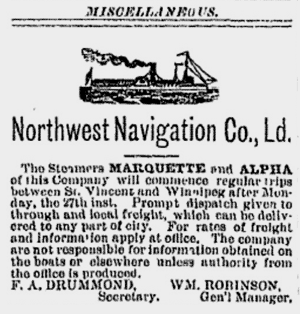
Clearly the owners were
expecting her to be in Winnipeg on, or soon
after, the 27th of April, when they placed this ad in the April 24th
edition. It doesn't rule out a Winnipeg to Souris Mouth route but the
ad certainly shows what service they ntended for the Alpha in the 1885
season.
After
some more searching I found corroboration of the Portage report.
The Winnipeg Daily Times, beginning on April 30, was able to keep its
reader’s updated.
“The
steamer Alpha …which left Brandon a few days ago for
this point, unshipped her rudder aout 100 miles east of Brandon and
damaged her hull so much that she had to be run up on a mud bank. The
accident is to be deplored as she had received a thorough outfitting
last winter. It had been intended to put her on the St. Vincent
route..” [39]
It
reported on May 1 that there was “no further word” on
the Alpha. And a follow-up report a few days later indicated that her
damage was “slight” and that she would be repaired as soon
as water levels allowed. [40]
In
April of 1885 the river had flooded its banks throughout the Spruce
Woods area. The valley floor, not nearly as heavily treed in those
days, would look like a large lake. The Captain likely cut across
a wide meander something often done especially on the upstream trip,
and ran aground almost due north of Cypress River. There was nothing
unusual about this, the steamers were always running aground – it
was expected. By a combination of reverse power, stout poles and
manpower, or a self-powered tow with a winch and a “nigger”
engine, they always got loose.
After
all, it had
certainly seen its share of mishaps. There were many adventures during
its runs northwards to Fort Ellice. It nearly sank in floodwaters west
of Brandon in the great floods 1882, escaping when another vessel
arrived and sixty head of cattle and horses were driven from one boat
to the other to lighten the load and luggage of all sorts was tossed
from rail to rail. Continuing, they often lost the channel, sometimes
running aground, sometimes having to tie up to a tree at night to avoid
drifting into danger. [41] Mr. Nelson Spencer recalled a voyage he took
in upriver 1883, as part of the Alpha crew. They were in sight of Fort
Ellice when the boiler sprang a leak so they had to unload cargo on the
riverbank and float back downstream for repairs. Apparently the boat
loaded up at Brandon and set out again, this time not making it past
18th Street! [42]
But
this grounding turned out to be a little more serious than usual.
When the crew was unable to free the boat they must have disembarked
and abandoned it.
Over
the ensuing years the locals salvaged and used much of the
accessible material, in one case building an entire barn with the
borrowed lumber, and left the skeleton to almost disappear beneath the
sandy valley bottom. Many homes in the Glenboro - Holland area once had
articles salvaged from the Alpha, but as time passed details such as
the name of the ship were forgotten. It was almost amusing to read the
report in the May 21 edition of the Brandon Weekly Sun and the May 22
edition of the Portage DailyTimes which reported that a Mr. Drummond
and Captain Duncan were sent to inspect on the wreck shortly after it
was grounded and the verdict was that it had been “perfectly
stripped” by the Indians. (In fact the headline was
“Stripped by Indians”) [43] No mention of the possibility
that the law-abiding homesteaders might have had a hand in it at all.
Perish the thought!
So that was it for
Assiniboine steamboats days, the Alpha was left
where it landed. The railway was taking over the freighting business
and boat just wasn’t worth the expense it would take to haul it
back to the channel.
I
was struck by the fact the Alpha, which had started the steamboat era
on the Assiniboine, ended it as well. It had adapted and moved with the
times. Built as a freighter, it had been soon renovated for passenger
service. And three years earlier, after being damaged in ice while
wintering at Brandon it had been lengthened by 20 ft and rebuilt.
Had it survived, it seems that it was destined for some service on the
Red, but the lifespan of such vessels was normally short and it had
certainly served it purpose.
I
surveyed the banks in each direction looking for signs. With nothing
to go by, I chose west and set out along the riverbank. Fifteen minutes
of breaking through undergrowth, and stumbling over deadfall, brought
me to a vantage point where the river bent to the south. I could see no
sign of anything man-made in the water or on the steep banks. But the
area looked right. I had studied the picture taken by Garth Stouffer of
the Brandon Sun on 1970. The steep riverbank, containing remains of the
port side were about twice the height of a man. I headed back to the
sand bar, then set out east.
I
wondered about the passengers and crew. No diaries or newspaper
accounts have survived of this trip. Travel, in general was a riskier
business on any frontier, or perhaps an adventure, to put a more
positive spin on it. The Alpha did often carry passengers and a Mr.
Alex Reid has left us a good account of a trip through these very parts
in 1881. [44]
I
had just about given up, convinced that I had covered the mile, and
that the thirty plus years since Roy Brown's visit had erased all
signs. I know that rivers are always changing. The soft sandy banks of
the Assiniboine wear away easily. New channels are carved, old ones
silted in. In fact the Alpha went down outside the channel which
was then 200 feet north of its present location and in the 1920's the
river changed course leaving the remains on the south bank of the new
channel. So, perhaps I was too late. Perhaps the remains were now
buried in the river bottom, or scattered downstream by floodwaters.
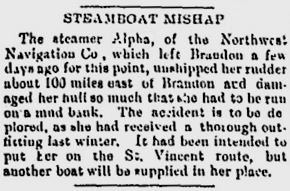
Winnipeg Daily Times
April 30, 1885
As I was about
to turn back, thinking I would have to bring in my canoe some day to do
a proper search, I remembered the description from Brown's book of the
old boat nearly buried outside the river channel with large cottonwood
trees growing right through it's timbers. And there, in front of me was
a large cottonwood tree! I went past it to get one last look downstream
before turning back, and there it was. Ten metres off shore a row of
beams protruded slightly from the water, far too neatly lined up to be
driftwood.
It
was quickly obvious that there was very little left of the
once-proud steamer, but as I approached, I was able to make out the
form, sort of fill in the blanks to get a mental picture. A closer look
revealed some planking still intact the under a few inches of water. I
also saw the fire bricks that were used to line the boiler.
I
was able to get a close look at the gigantic timber that must have
formed the keel or a side rail. Imagine it being intact after 118 years
on the river bottom? I imagined time taking its toll. I had copies of
Roy Browns 1970 photos and it was easy to see that perhaps 10 metres of
the river bank had been eaten away since that time. I later discovered
a 1958 photo by Chris Vickers showing the prow clearly protruding from
the stream. It was successfully salvaged and is displayed in a roadside
park in Glenboro.
The
river had now freed the skeleton. As that happened spring floods
and ice breakup dismantled the remains. Some parts were likely washed
downstream, but waterlogged wood is very heavy and a good part has
remained lodged in the sand. All-in-all the river has probably revealed
more than it has dispersed - except that the remaining structure is
usually under a few feet of water.
One
large plank with the points of a number of large square hand-made
nails exposed sat just above the water line. In a few days it would
begin to dry out. If we were to get a warm October it would soon be
light enough to float away if the river level came up even ten
centimetres. We considered salvaging it, but I couldn’t believe
how heavy it was when we tried to pull it out of the sand. We settled
for re-locating it to a safe spot up the bank. I did bring back a small
piece of plank that had already been exposed long enough that next
springs water would surely take it away.

The
Site

This photo by Chris Vickers
shows the a
portion of the Alpha's remains as they looked in 1958.
(Photo courtesy of the Manitoba Archives)
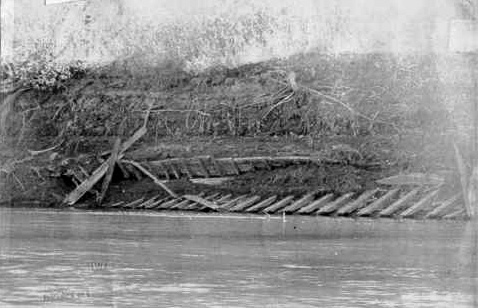
Roy Brown's
photo from
1970. Much of the structure was embedded in the sandy bank.
(Photo courtesy of the Daly Museum in Brandon)
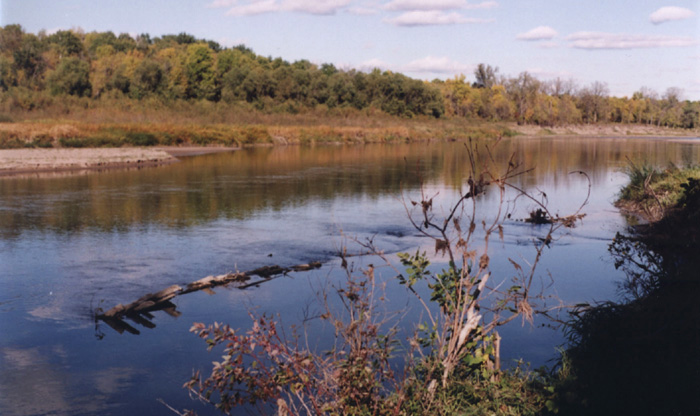
My first view of the
remains of
the Alpha. Fall of 2003. The river bank had eroded towards the right
since 1970.
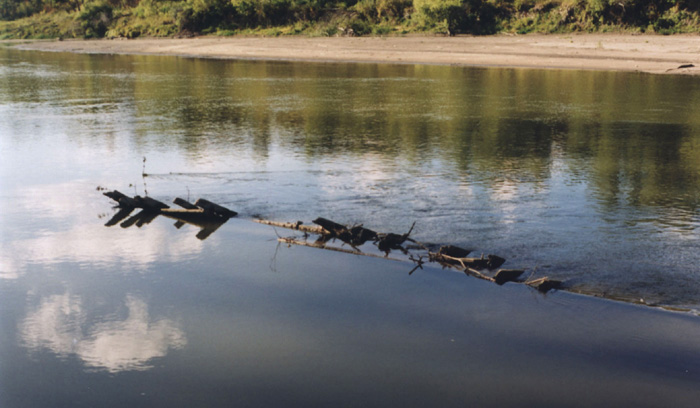
By 2001 the
remains were
several metres out into the river.
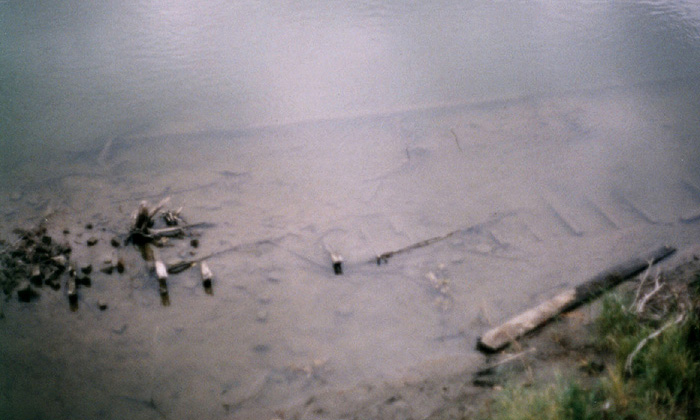
Covered by only a
few inches of
water, the scattered debris, including a large beam, was quite visible.
The
story of the Alpha is more than the story of a lost boat. It is the
story of a short, but notable period in our settlement history. A
period that was both unique to Western Manitoba, yet reflective of
patterns established across the continent as our forefathers pushed
relentlessly westward from their initial tentative perch on the eastern
shores of North America.
In
western Manitoba, the 1880's were times of incredible change.
In 1879 the land was sparsely peopled, housing scattered fur trade
posts, itinerant native bands, and a few hardy isolated farmers. Travel
was by Red River Cart, horse, canoe, and of course, by foot. Pemmican
or other dried food was still on the menu, gardens were rare, and new
arrivals sometimes lived for whole winters on oatmeal and a few snared
rabbits.
By
1890 regular train service was beginning to reach into the southwest
corner of the province. Prairie wagon tracks were becoming graded
trails with bridges and culverts allowing passage over streams.
Villages were established, often along new rail lines, and a variety of
goods an services were readily available.
As
had happened in the American west, and just slightly east in the Red
River valley, steamboat service was established in that interim period
between the first flow of settlers and the arrival of the railroads. In
a way it helped create the demand for rail service, in that it helped
settlers get here and get established, which soon led to an abundance
of crops requiring efficient routes to market.
A
traveler who passed through in 1879, then returned in 1890 would see
a much altered landscape. It would be a landscape that was shaped by
newcomers, with communities whose creation was enabled by a
transportation revolution. In that revolution, the steamers played
their brief but telling role. But even by 1890, the physical evidence
of that role was almost gone. And today with the last of that physical
evidence literally washing away.
Roy
Brown began a process of reclaiming that little bit of history
withy his work in the 1970's. The rudder of the Alpha has since been
lifted from the river and displayed in a roadside park at Glenboro. His
booklet, "Steamboats on the Assiniboine" was re-published as part of
Brandon's 125th Anniversary.
I
submit this project as another step in the process of establishing a
more complete and accessible record of those interesting times.
Another thirty years may complete the river’s work. There may be
nothing left to find for the next local history / outdoors enthusiast
who happens upon the story and takes the same trail we did.
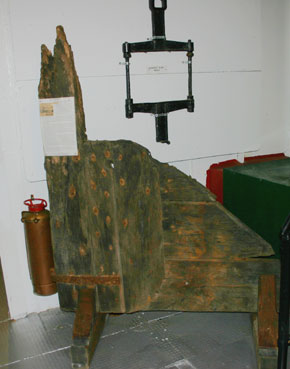
The rudder
and
quadrant
from the Alpha on display at the Manitoba Maritime Museum in Selkirk.

Sources
1.
Cypress River: Pioneers, Perseverance & Progress. Cypress River
1885-1985
2.
Brown, Roy, Steamboats on the Assiniboine, Tourism Unlimited,
Brandon Mb
3.
"False Starts : The Story of Riverside Settlements in the Souris
Mouth Area" 1998
4.
Barris, T. Fire Canoe: Prairie Steamboat Days Revisited. Toronto:
McClelland and Stewart 1977 21
5.
Winnipeg Daily Times, April 27, 1880
6
Wyatt, George H. A reliable guide for settlers,
travellers & investors in the city of Winnipeg, Manitoba and the
new North-West (Toronto: s.n., 1881.)
http://peel.library.ualberta.ca/bibliography/1021.html
7.
McCarthy, Martha, Steamboats on the rivers and lakes of
Manitoba 1859-96
Historic
Resources Branch, 1987. 80
80 “Flatboat” was a nickname used by the press and
others, I suppose in tribute to his contributions to the shipping
industry.
8.
P375 Berton, Pierre, The National Dream (Penguin Books Canada,1989)
375
9.
Berton 272 And McCarthy, Martha Steamboats on the rivers
and lakes of Manitoba 1859-96 Historic Resources Branch, 1987. 25
10.
The Standard, Winnipeg MB May 8 1875
11.
The Manitoba Free Press, Winnipeg MB May 18 1878
12.
The Manitoba Free Press, June 14 1873
13.
McCarthy p 25
14.
The Manitoba and Northwest Herald, Nov. 1, 1873 P3
15.
The Nor’Wester May 24, 1875
16. The Manitoba Free
Press. August 19 1876
17.
The Manitoba Free Press. May 11, 1878
18..
Winnipeg Daily Times, Sept. 8, 1879
19.
Winnipeg Daily Times, April 16, 1880
20.
The Manitoba Free Press. March 30. 1878
21.
The Manitoba Free Press. May 11, 1878
22. Brown 19
23.
Macoun,
John, Autobiography of John Macoun, M.A.: Canadian explorer and
naturalist, assistant director and naturalist to the Geological Survey
of Canada, 1831-1920 (Ottawa, 1922), 583
23A.
Winnipeg Daily Times, July 10, 1879
24.
Oakland Echoes, A.E. Rome 22
24A.
Winnipeg Daily Times, Oct. 8. 1879
25.
Glenboro and Area Historical Society, Beneath the Long Grass,
1979 15
26.
Brown 77
27.
Wilson Navigation North and West Steamboat Bill of Facts.
American Hist Society June 1953 p37
28.
Berton. Pierre,The Last Spike, 14
29.
Macoun,
John, Autobiography of John Macoun, M.A.: Canadian explorer and
naturalist, assistant director and naturalist to the Geological Survey
of Canada, 1831-1920 (Ottawa, 1922), 183,184
30
Brown 53
31.
Winnipeg Daily Times, May 18, 1881
32.
Winnipeg Daily Times, May 10, 1881
33.
Winnipeg Daily Times, Sept. 20, 79
34.
Winnipeg Daily Times, July 18,1881
35.
Winnipeg Daily Times, May 27, 1879 & The Manitoban, June 2, 1882
36.
Brandon Sun Weekly, Nov. 10, 1884
37 Brandon Sun articles
twice mentions that Alpha was waiting out the
winter there. 13/11/84 A mention of the owners getting her in
“readiness” and another speculating that she was being
fitted up “so as to be ready when navigation opens to proceed to
Winnipeg. She will ply on the Red River.” 05/02/85 and a
contradictory note saying she would “ply this season on the
Assiniboine north of the city” 12/03/85
38.
Portage La Prairie Weekly, May 1, 1885
39.
Winnipeg Daily Times, April 24, 1885
40.
Winnipeg Daily Times, May 1 & 4, 1885
41.
Brown 58,59
42.
Brown 65, 66
43
Brandon Sun Weekly
44.
Alex Reid, Letters and Journal, Archives of Manitoba,
Microfilm Ref. MG8 B61

|
 |
 |
|
|